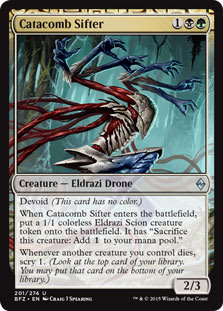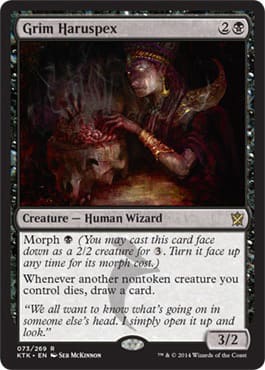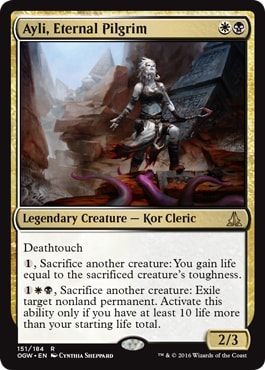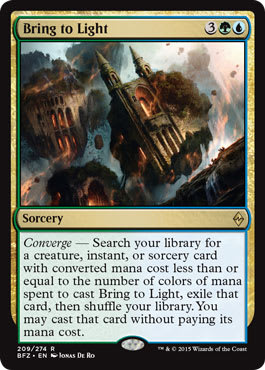Combo has so many meanings in Magic and is thrown around in conversation as a noun (“This is my favorite combo”), a verb (“I got combo’d on turn three”), or an adjective (“It’s a combo deck”), and today, we’re going to talk about a pretty popular sect of combo–grindy combo decks.
For those newer to the game, grinding is an in-game term that generally describes trading resources with your opponent and trying to leverage small advantages while doing so. Generally speaking, these lines of play occur when players are trying to maneuver their cards into gaining card advantage through whittling down their opponents’ cards or increase their own. The most popular example of this in Magic right now is the Rally the Ancestors deck in Standard.
At its heart, the Rally the Ancestors deck plans to load up the graveyard and use Nantuko Husk to turn on all kinds of synergies to kill the opponent with the deck’s namesake—usually via several Zulaport Cutthroat triggers. When Oath of the Gatewatch was printed, the deck became significantly better at grinding with the inclusion of Reflector Mage as a way to stay ahead on the battlefield. It definitely drove a divide through how people prefer to build their decks, and it’s incredibly telling to see how a person plans to play his or her cards based on that player’s particular build of the deck. I prefer to play a more combo-centric version of the deck, and it often shows in my play and deck construction. For reference:
Combo Rally the Ancestors ? Oath of the Gatewatch Standard | Emma Handy
- Creatures (27)
- 4 Jace, Vryn's Prodigy
- 4 Elvish Visionary
- 3 Catacomb Sifter
- 4 Reflector Mage
- 4 Nantuko Husk
- 4 Zulaport Cutthroat
- 3 Sidisi's Faithful
- 1 Grim Haruspex
- Spells (9)
- 4 Collected Company
- 4 Rally the Ancestors
- 1 Dispel
- Lands (24)
- 4 Windswept Heath
- 4 Flooded Strand
- 4 Polluted Delta
- 3 Evolving Wilds
- 1 Plains
- 1 Island
- 1 Swamp
- 1 Forest
- 2 Canopy Vista
- 1 Prairie Stream
- 2 Sunken Hollow
- Sideboard (15)
- 1 Grim Haruspex
- 2 Dispel
- 1 Hallowed Moonlight
- 1 Kalitas, Traitor of Ghet
- 2 Anafenza, the Foremost
- 1 Duress
- 1 Fleshbag Marauder
- 1 Merciless Executioner
- 1 Ayli, Eternal Pilgrim
- 2 Murderous Cut
- 2 Arashin Cleric
This particular list is very interested in setting up the Rally the Ancestors combo-kill and protecting it. It is made relatively apparent by the high number of Dispels and lack of extraneous effects that pay off in longer games (looking at you Liliana, Heretical Healer) in order to increase the velocity of the deck. In order to explain the differences between this and a “fair” version, let’s look at another variant that draws a good bit from the Jacob Baugh school of thinking:
Grindy Rally the Ancestors ? Oath of the Gatewatch Standard | Emma Handy
- Creatures (28)
- 4 Jace, Vryn's Prodigy
- 2 Elvish Visionary
- 2 Ayli, Eternal Pilgrim
- 4 Sidisi's Faithful
- 1 Liliana, Heretical Healer
- 4 Nantuko Husk
- 4 Zulaport Cutthroat
- 4 Reflector Mage
- 3 Grim Haruspex
- Spells (8)
- 4 Collected Company
- 3 Rally the Ancestors
- 1 Bring to Light
- Lands (24)
- 3 Windswept Heath
- 4 Polluted Delta
- 4 Flooded Strand
- 3 Evolving Wilds
- 1 Plains
- 1 Swamp
- 1 Island
- 1 Forest
- 2 Canopy Vista
- 2 Prairie Stream
- 2 Sunken Hollow
- Sideboard (15)
- 1 Fleshbag Marauder
- 1 Merciless Executioner
- 2 Abzan Ascendancy
- 2 Duress
- 2 Arashin Cleric
- 1 Kalitas, Traitor of Ghet
- 2 Anafenza, the Foremost
- 1 Liliana, Heretical Healer
- 1 Felidar Cub
- 2 Murderous Cut
When looking at the two decks side by side, it’s easy to quantify the differences between the two lists, but understanding why the decks are different has just as much value as the card counts.
The creatures are the first place to really dig in and see what each deck is trying to accomplish. If a Rally player is playing the full set of Elvish Visionary, it is abundantly clear that player is digging for specific cards and wants to see as much of his or her deck as possible.
Playing Catacomb Sifter over Grim Haruspex communicates that a deck cares more about finding a specific card in favor of a bunch of random cards. The two cards may have similar text boxes, but the cards play very differently in game. The extra point of toughness is an enormous deal, and opponents tend to handle the two cards very differently. Many opponents fail to realize the intrinsic value behind gaining several scry effects over the course of a game, and it’s a rarity that somebody doesn’t understand how powerful card-draw is.
Ayli, Eternal Pilgrim being relegated to the sideboard in the first list somewhat communicates that the former deck just wants to have a sacrifice outlet that is more mana-efficient in conjunction with cards that generate more value off Rally the Ancestors itself. Her inclusion in the second decklist telegraphs a plan to be involved in combat and an interest in synergizing with Grim Haruspex. Ayli really shines against the various Siege Rhino decks as a creature than is nearly unblockable on offense and one of the better defenders in the format. She cannot be exiled by Abzan Charm or dealt lethal damage by Kolaghan's Command, and she is incredibly helpful when it comes to trading up against larger threats.
Liliana, Heretical Healer contributes some amazing things to this archetype’s “fair” game plan, and it isn’t just in her ability to resurrect creatures. One of the Defiant Necromancer’s strengths is her ability to force both players to focus on the battlefield and remove players’ hands from the equation. One of the ways that Rally will tend to lose fair games is through endless streams of cards that come out of the Mardu Green and Jeskai Black decks. Liliana makes sure that these decks have to fight on the board, where Rally the Ancestors is generally favored. Despite her synergies in the deck, Liliana doesn’t always contribute to the core combo, and she ends up on the cutting-room floor of combo-centric builds of the deck. By extension of the Liliana, Sidisi's Faithful often gets a nod in decks that include the Planeswalker. It’s among the easiest ways to transform Liliana and helps her do an amazing Jace, the Mind Sculptor impression.
Moving down to the spells, the first deck isn’t messing around with anything for fun or attempting to interact with the opponent. The four Collected Company and four Rally the Ancestors is pretty standard when looking at most decks, but the Dispel is something I started playing back in December, and it has started to catch on a bit more as the deck became more popular. The biggest use for Dispel is usually countering counterspells or other cards that will prevent your Rally the Ancestors from resolving; Caleb Durward was main-decking Hallowed Moonlight in Mardu Green this past weekend, and Dispel is a flexible way to pull out ahead of people trying to interact with Rally on the stack.
Where the first deck is relatively boring and straightforward, the latter deck is much spicier. Bring to Light is an addition that Matt Tickal and Eric Hawkins brought to the table later last year, and they revisit the idea regularly. It generally serves as a fifth copy of Collected Company, but it does so much more when your games go long. There are many games in which the Rally player will resolve a Collected Company, hit Jace, Vryn's Prodigy, use it to flash back Collected Company, and never have anything else to do with Jace, Telepath Unbound. This line of play is incredibly powerful and may sound like a Magical Christmas Land of sorts, but it’s not an uncommon turn-four play. When Bring to Light is involved, it puts two spells into your graveyard to flash back. This ends up being an enormous deal in decks with which going long is favorable and the goal is just to amass as many resources (read: creatures) as possible. In post-sideboard games, Bring to Light also serves as additional copies of sideboard cards that you can’t quite justify playing very many of, such as Kalitas, Traitor of Ghet or Felidar Cub, without removing consistency from the deck.
A copy of Rally the Ancestors being shaved in the latter list communicates that the grindy variants want to use it as a nail in the coffin, so to speak, rather than hinging a majority of their games on resolving a copy of the instant. It can also communicate that Rally the Ancestors is more of a value card than something that the deck plans to proverbially “charge and fire” at the end of a game. The way the games play out, it isn’t too crazy to imagine a world in which Grim Haruspex keeps the grindy deck’s hand and board full through attrition and Rally the Ancestors isn’t as necessary.
The biggest difference to note between these two decks isn’t necessarily in the cards they aren’t playing when comparing them to one another, it is in how the decks will battle against other decks in actual games of Magic. This translates very similarly into other formats when deciding what kind of deck a player should decide to pilot. In Modern, for example, if you’re more interested in comboing against your opponent, but not being dead in the water if he or she has a timely Pithing Needle, Melira Company is your deck in Modern. If you want something that can go toe to toe with the best Jund decks but have a panic button of sorts, Kiki-Chord may be more your speed.
When choosing to build, play, and truly pilot a combo deck proficiently, it is important that we as players don’t just look at the cards on a decklist. Looking at the cards around them is very telling of the pilot’s intentions in a game of Magic and how he or she is going to give him or herself the best odds to win every game of Magic the player plays.






























